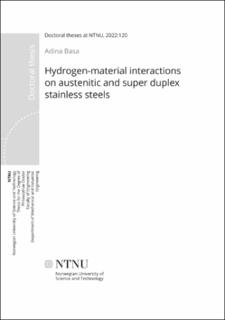| dc.contributor.advisor | Espallargas Alvarez, Nuria | |
| dc.contributor.advisor | Olsen, Vigdis | |
| dc.contributor.advisor | Wan, Di | |
| dc.contributor.author | Basa, Adina | |
| dc.date.accessioned | 2022-04-20T08:25:46Z | |
| dc.date.available | 2022-04-20T08:25:46Z | |
| dc.date.issued | 2022 | |
| dc.identifier.isbn | 978-82-326-5250-1 | |
| dc.identifier.issn | 2703-8084 | |
| dc.identifier.uri | https://hdl.handle.net/11250/2991527 | |
| dc.description.abstract | The interaction between hydrogen and structural materials has been intensively studied for many years. In this PhD thesis the effect of hydrogen on the mechanical properties of two stainless steels has been investigated mainly through the means of electrochemical nanoindentation technique. The two materials studied were an austenitic AISI 316L and a super duplex stainless steel (SDSS, UNS S32507) and the hydrogen effects on the nanomechanical properties were analysed in terms of the homogeneous dislocation nucleation (HDN) and the hydrogen-dislocation interactions from an energy point of view. On the austenitic stainless steel, it was reported the interconnection of the electrode potential with the nanomechanical properties. It was found that more positive cathodic potentials have a softening effect, while more negative cathodic potentials result in a significant hardening. Also, there is a clear difference in the load - displacement curves resulting from nanoindentation testing under hydrogen charging, where the curves are similar in air and under anodic potentials, while under cathodic potentials, both the pop-in load and pop-in width decrease with increasing the cathodic charging. The effect on the austenitic stainless steel was explained with the defactant theory and the hydrogen-enhanced localized plasticity (HELP) mechanism. Under hydrogen charging a reduction in the pop-in load and width was reported on both the austenitic and ferritic phases of the SDSS sample, while the hydrogen effect on the material hardness was larger for the austenitic phase than for the ferritic one, due to the higher solubility of hydrogen in the austenite than in the ferrite phase.
Secondly, the oxygen argon plasma (OArP) treatment was studied in this PhD thesis as a new method for controlling hydrogen uptake during cathodic protection. It was found that treating the samples with OArP prior testing did not affect the nanomechanical properties or the dislocation nucleation process of the material, but it greatly inhibited the effect of hydrogen under in situ electrochemically hydrogen charging. Topography images made on the two alloys investigated showed no differences on the pile ups around nanoindentations made prior and after OArP treatment. Also, no slip lines were observed on the OArP treated samples, not even after 6 hours of hydrogen charging, while after only 85 minutes of hydrogen charging on a freshly electropolished SDSS sample, a clear effect of hydrogen on the austenitic grains was shown by the slip lines captured and/or martensite formation on the sample’s surface.
During material testing, a phase transformation could be triggered not only during hydrogen charging but it was also observed when other chemical elements were implanted into the surface. In this PhD thesis, it was concluded that it is important to wisely choose the methods for creating samples due to the effect that the chemical elements can have on the specimens. Focused Ion Beam (FIB) uses gallium ions and a chemically induced austenitic-to-ferritic phase transformation in a highly stable austenite phase of a SDSS sample has been found on the areas milled with gallium ions. In an independent test, several regions were milled under FIB using 3 different gallium ion doses at different acceleration voltages and the phase transformation occurred within the milled areas. By locally increasing the amount of gallium, which is a ferrite stabilizer, the chemical composition of the austenite was changed, and this resulted in the selective transformation of austenite to ferrite. | en_US |
| dc.language.iso | eng | en_US |
| dc.publisher | NTNU | en_US |
| dc.relation.ispartofseries | Doctoral theses at NTNU;2022:120 | |
| dc.relation.haspart | Paper 1: Barnoush, Afrooz; Basa, Adina; Thaulow, Christian. Oxygen argon plasma treatment effect on hydrogen uptake in austenitic stainless steels. International Journal of Hydrogen Energy 2014 ;Volum 39.(26) s. 14120-14131 | en_US |
| dc.relation.haspart | Paper 2: Basa, Adina; Wang, Dong; Espallargas, Nuria; Wan, Di. An in-situ electrochemical nanoindentation (Ecni) study on the effect of hydrogen on the mechanical properties of 316l austenitic stainless steel. Materials 2021 ;Volum 14.(21) s. 1-19 | en_US |
| dc.relation.haspart | Paper 3: Basa, Adina; Thaulow, Christian; Olden, Vigdis. In situ nanoindentation testing of hydrogen degradation on super duplex stainless steel. International Conference on Steel and Hydrogen; 2011-09-28 - 2011-09-29 | en_US |
| dc.relation.haspart | Paper 4: Basa, Adina; Barnoush, Afrooz; Thaulow, Christian. Nanomechanical Testing of Hydrogen Effects on Super Duplex Stainless Steel. International Conference Diagnosis and Prediction in Mechanical Systems Engineering; 2012-05-31 - 2012-06-01 | en_US |
| dc.title | Hydrogen-material interactions on austenitic and super duplex stainless steels | en_US |
| dc.type | Doctoral thesis | en_US |
| dc.subject.nsi | VDP::Teknologi: 500 | en_US |
